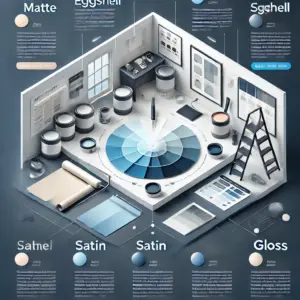Business
Optimal Paint Finishes for Enhancing Your Commercial Space
Table of Contents
- Introduction to Paint Finishes
- The Importance of Choosing the Right Finish
- Common Types of Paint Finishes
- Matte and Flat Finishes
- Eggshell and Satin Finishes
- Semi-Gloss and Gloss Finishes
- Factors to Consider
- How Paint Finish Affects Durability
- Cost Implications of Different Paint Finishes
- Tips for Applying Paint Finishes in a Commercial Setting
- Conclusion: Making the Right Choice for Your Space
Painting might seem straightforward, but selecting the right finish is crucial when it comes to commercial painting. This decision can significantly shape a workplace’s aesthetic and functional aspects, impacting how it feels and operates daily. The right choice can elevate the ambiance, complement the decor, and mitigate maintenance concerns over time. For businesses, an informed decision on paint finishes can result in a workspace that looks inviting, durable, and easier to maintain.
This comprehensive guide will explain everything you need to know about selecting the best paint finish for your commercial setting. From understanding the different types of finishes to evaluating crucial factors and providing practical application tips, this article is designed to help you make a decision you won’t regret.
Introduction to Paint Finishes
A paint finish refers to a painted surface’s final aesthetic and texture and is an essential element for appearance and function. The finish not only contributes to a room’s visual appeal but also influences how light reflects off surfaces, affecting the room’s overall atmosphere. It’s more than a final touch; it’s a strategic choice that impacts daily operations and atmosphere, leaving a lasting impression on employees, partners, and clients.
The Importance of Choosing the Right Finish
The appropriate paint finish is vital for a cohesive and practical interior environment. The right finish enhances architectural features, reinforces brand identity, and creates a tailored atmosphere suited to the business’s function. It can mask imperfections or highlight unique structural elements. Conversely, an unsuitable finish can increase maintenance needs, show every scratch or fingerprint, and degrade the professional appearance of the business space.
Common Types of Paint Finishes
Matte and Flat Finishes
Matte and flat finishes absorb light rather than reflecting it, giving walls a rich, velvety texture. They’re excellent at hiding imperfections, making them popular for spaces where aesthetics override the need for frequent washing. Think of private offices or specific lounges, where traffic is minimal, and the ambiance calls for warmth and subtlety.
Eggshell and Satin Finishes
Eggshell and satin finishes offer a slight luster to add a gentle glow to walls without being overly shiny. These are versatile options for spaces that balance activity with elegance, such as conference rooms or hallways. Their balance of sheen and texture adds sophistication while sufficiently durable for mild cleaning, accommodating moderate foot traffic and usage.
Semi-Gloss and Gloss Finishes
Semi-gloss and gloss finishes are the top choices for areas requiring resilience and regular cleaning. They are highly reflective, making rooms appear larger and more vibrant. While they exude a modern, crisp aesthetic ideal for kitchens, bathrooms, or other high-traffic zones, they also reveal wall imperfections. The strategic placement of these finishes enhances functionality with a polished look.
Factors to Consider
When choosing a paint finish, consider the room’s purpose, lighting (both natural and artificial), and desired mood. Traffic levels and how often you need to clean the space are critical aspects, too. A break room will have different requirements than a formal office area. These considerations ensure the finish supports the room’s utility and design goals.
How Paint Finish Affects Durability
The durability of paint finishes is a decisive factor for commercial settings. Gloss paints are robust against daily wear and tear, resisting stains better than their matte counterparts. This aspect is pivotal for rooms with high interaction or where cleanliness is non-negotiable. Investing in a durable finish can pay off by minimizing long-term upkeep and preserving the appearance of the space.
Cost Implications of Different Paint Finishes
The price of a paint finish can vary, affecting the project budget. While matte finishes might present a lower upfront cost, their maintenance might lead to higher expenses over time due to frequent touch-ups or cleaning challenges. Conversely, gloss finishes, though more expensive initially, boast longevity and ease of maintenance that could prove cost-effective, especially in bustling commercial environments.
Tips for Applying Paint Finishes in a Commercial Setting
Preparation is key. Ensure surfaces are thoroughly cleaned and sanded before painting. Use a suitable primer to achieve a smooth, even application and prolong the paint’s life. Employing high-quality materials and tools can markedly influence the outcome. It might be wise to engage professionals, especially for large commercial projects, to guarantee a uniform finish and professional look. Expert insights can significantly enhance your painting results, offering slick techniques and time-saving advice.
Conclusion: Making the Right Choice for Your Space
Choosing the right paint finish is an intricate process that combines aesthetic preferences with practical needs. Businesses must analyze their specific requirements, style, maintenance, or functionality to make a selection that supports their goals. By blending strategic choices with professional advice, businesses can craft commercial spaces that are visually appealing and effectively suited to their operations, improving employee satisfaction and brand image.





